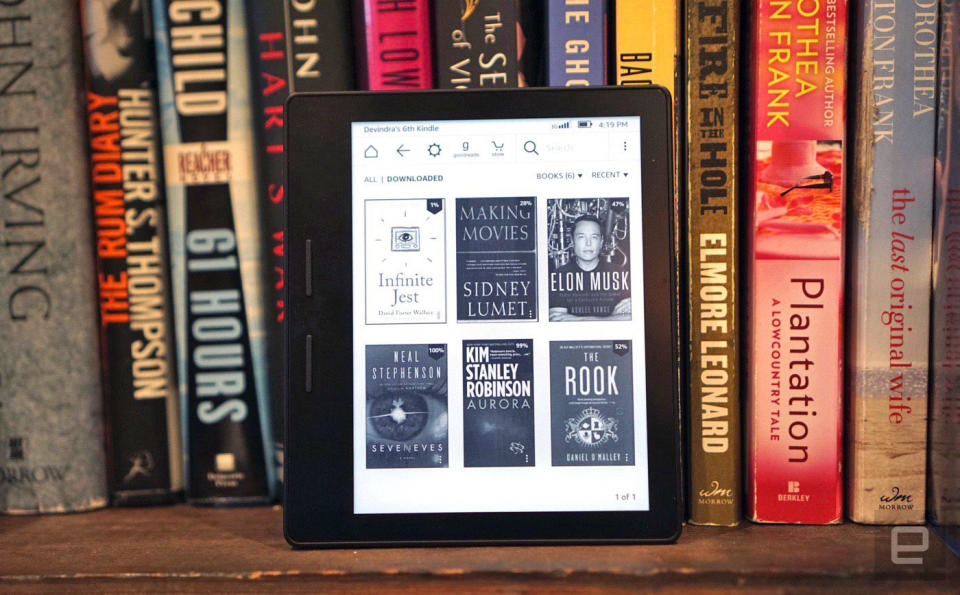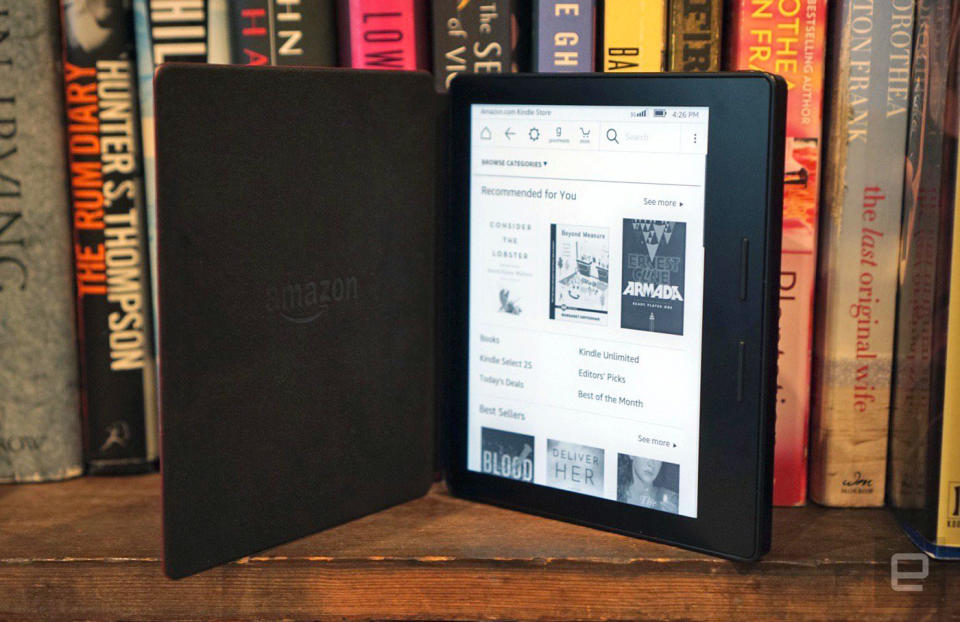Kindle Oasis review: The perfect e-reader for the 1 percent
It’s the best Kindle yet, but there’s no reason to spend $290 on it.

Amazon's Kindle Oasis is like a feast with the world's finest caviar. It's an all-you-can-eat Wagyu steak dinner. It's an $80 cup of coffee. Simply put, the Oasis is a $290 extravagance meant only for the few who can afford it. For the rest of us, it's just something to lust after. We called the $200 Kindle Voyage the "Rolls Royce of e-readers" two years ago, but instead of going cheaper (the standard Kindle is currently $60, and the backlit Paperwhite model is $100), Amazon pushed even further into luxury status. For $290 you get an e-reader so light it almost feels like you're holding nothing at all. Unfortunately, Amazon still hasn't made a strong argument for why anyone actually needs a high-end reading device.
Hardware

I've held plenty of e-readers, tablets, smartphones and other gadgets over the years, and few were as remarkable as the Oasis. When you look at it head-on, it's unmistakably a Kindle, even though its 6-inch E Ink display is pushed to the side to make room for two physical page-changing buttons (answering the prayers of Engadget's Chris Velazco). But tilt it slightly and you'll notice that it's, well ... sort of funky. Most of the device is insanely thin -- a mere 3.4 mm -- while the rest is a slightly thicker hump meant for gripping one-handed.
Its asymmetric design looks weird at first, but it only takes a few seconds to get used to it. That's mostly because it's light -- crazy light, at just 4.6 ounces. To compare, the Voyage weighs 6.3 ounces, and the Paperwhite clocks in at 7.2 ounces. Those don't sound like huge differences, but they're noticeable when you're holding something for hours on end. The Voyage and the Paperwhite are close to the weight of a typical paperback. The Oasis, on the other hand, is so featherweight it almost feels alien as a reading device.

"We're not going to be happy until we've got this magic sheet of paper that contains all the books in the world," said Chris Green, VP of industrial design at Amazon's Lab126, during our initial demo of the Oasis. "Edge-to-edge, all content, no device. And when we get there, I might be out of a job."
Despite being so thin, Amazon's latest Kindle is also surprisingly sturdy. The company says it electroplated a metal alloy over a plastic case to make that happen. You won't feel or hear any creaking when using the Oasis, and it barely even flexes when you try to bend it. The edges and thin portion of the Oasis feel cool and smooth, while the hand-grip portion has a slightly softer touch.
Once again, Amazon used micro-etched glass for the Oasis' screen, which should make it even more resistant to glare (it's also stronger than the Voyage's). The new model's screen still packs in a sharp 300 pixels per inch, which looks about as good as printed text on paper. That's the same resolution you get with the Voyage and the Paperwhite, though you do get 60 percent more LED lights here than on the Voyage. That's nothing big, but it makes for a more uniform lighting presentation overall. I know plenty of Kindle fans who were irked by the Voyage's slightly uneven lighting, which was particularly annoying given the price.
There's also a leather case included with the Oasis (available in black, walnut or merlot), which doubles as an extra battery pack to make up for the Kindle's reduced battery size. (Amazon had to give something up to make the Oasis so thin, after all.) The case snaps right onto the angled portion of the Oasis' back and adds another 3.8 ounces to the Kindle's weight when connected. Thankfully, you can charge the Kindle and the case together.
Software

Not surprisingly, the Oasis ships with Amazon's most recent Kindle operating system, which hit its existing devices back in February. It's mostly an organizational facelift. Now, the home screen shows the most recent books you've been reading on the top left; a selection of titles added to your wish list (which is a seriously great addition); and some suggested books on the bottom. You can also access settings like airplane mode (a great way to save battery life) and data syncing from the Oasis' toolbar, which saves you from hopping into the settings page as you had to do on previous versions of the Kindle OS.
In use

It's no surprise that books and black-and-white comics look great on the Kindle Oasis: Amazon pretty much mastered that with the Voyage's 300-ppi E Ink screen. For lack of a better word, there's an "inkiness" to the display that makes text and line art appealing to your eyes. It's completely different from a backlit smartphone or tablet, which can be just as sharp but can also feel like it's attacking your eyes with light. Reading on the Kindle Oasis (along with the Voyage and the Paperwhite) is more like settling in with a book right next to a gentle lamp. There's something soothing about it.
Given that Amazon has been using the same E Ink panel for years now, it's hard not to think that this will be as good as it gets for black-and-white E Ink displays. Sure, it could try to stuff in a larger screen (the DX was a failed attempt at that), and of course color E Ink could happen eventually (though the improvement of tablet screens has made that less pressing).
The most noticeable improvement with the Kindle Oasis is the way it feels while you're reading. Its lightweight, asymmetric design makes it ideal for holding with one hand and lounging on the couch or in bed. In my first few days with the Oasis, I easily dove into several titles that were gathering digital dust in my Kindle library, including Nick Bostrom's Superintelligence: Paths, Dangers and Strategies, Ashlee Vance's Elon Musk biography and Daniel O'Malley's The Rook. It may have just been the shininess of a new gadget compelling me, but I noticed that my reading sessions with the Oasis were much longer than with the Voyage. The anal-retentive side of me also appreciated its more uniform backlight; there's none of the splotchiness found on cheaper Kindles.

I was so enamored with the Oasis' design that I used its included leather case only for traveling. It's not exactly heavy when the case is connected -- I had no problem keeping it on during crowded subway rides -- but the Oasis feels so good on its own that there's no reason to have any extra burden unless you really need it. The case itself feels like a high-quality piece of leather, and does a good job protecting the Kindle's precious screen.
It's also a great travel companion, since it has its own battery and extends the Oasis's runtime to around eight weeks on standby. (Amazon says the Kindle should last around two weeks by itself.) From full charge, the Oasis and its case lost around 20 percent of battery life after a week of heavy reading. Basically, it should last so long that the notion of recharging it will probably rarely cross your mind.
As great as the Oasis feels, be prepared to wipe off plenty of fingerprints if you want to keep it looking pristine. It attracts far more oil and smudges than any previous models -- so much so that it's even worse than the Voyage, which has a glossy rear case.
Other options

Here's where things get muddy for the Oasis. I've been a dedicated Kindle fan since the Kindle 2 launched in 2009, and I've followed along with Amazon as it steadily improved its lineup. The Oasis, for all of its design flourishes, isn't that much better than Amazon's current batch of Kindles. And it's certainly not worth a $90 premium over the Kindle Voyage, which was already overpriced ever since it launched at $199.
With the Kindle Paperwhite, which also packs in a sharp screen and backlight, available for $100, there's simply no reason for most people to even consider the Oasis. It would have made more sense for Amazon to nix the Voyage and price the Oasis at $200 (or even slightly more). Asking $290 ($20 more than an iPad Mini 2) is simply madness.
Wrap-up

I get it. Amazon wants to prove that its Kindle brand has a place in the premium gadget market. But that's an idea that seems dramatically out of step with reality, as more people are getting used to reading books on their phones and tablets. The Kindle Oasis is indeed the best Kindle ever made. But instead of making the case for expensive e-readers, it makes clear that they just don't make sense today.
I'm certainly intrigued by how Amazon plans to evolve the Kindle, but it also needs to do so in a way that's practical. I can't wait for the "magic sheet of paper" that the company apparently dreams of. I just want it to do much more than the existing Kindle lineup. And of course, I'd want it to be affordable, too.















